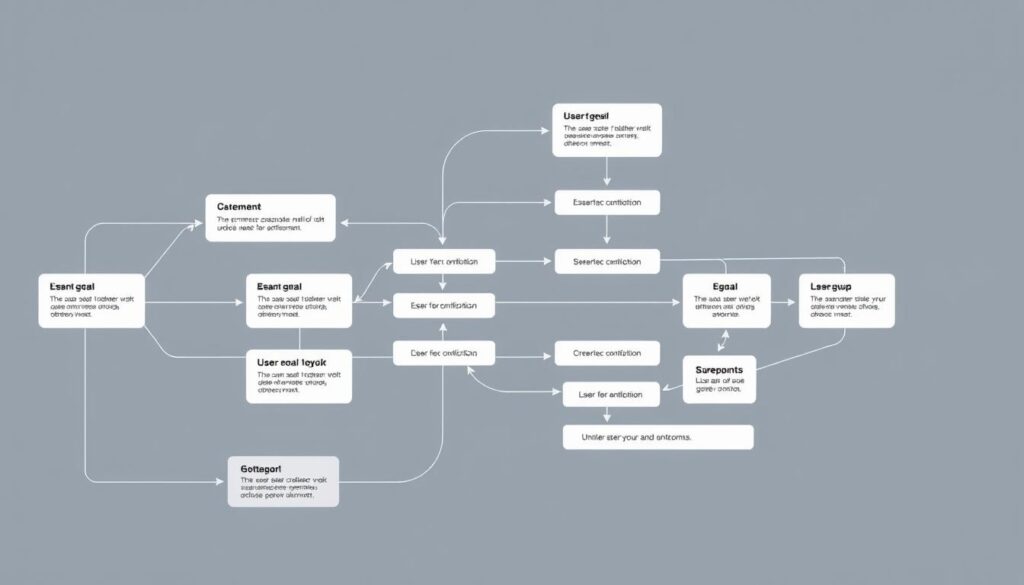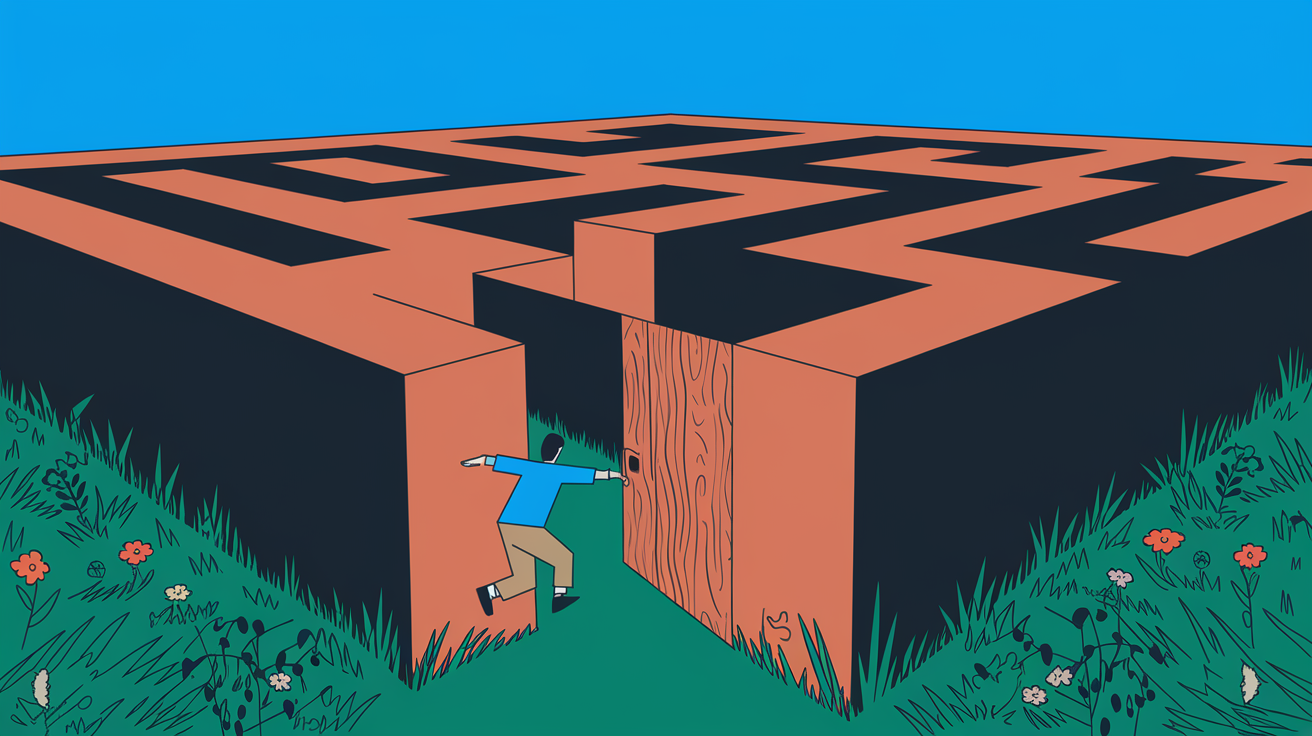User flow diagrams are essential tools in User Experience Mapping. They show how users move through websites or apps. This helps teams understand how customers interact and make the experience better.
Many senior UX designers skip using user flows, but junior designers might find it hard to create them well. This shows that we need to know more about User Flow Diagrams and their role in mapping customer journeys.
User flows are different from user journeys as they focus on specific steps in a product. Shapes and colors help show what’s in the interface. For example, circles represent actions, and diamonds represent decisions.
Getting good at creating user flows takes time and practice, but it’s crucial for UX pros. It helps avoid mistakes, saves time, and smooths users’ experiences on different platforms.
Ready to dive deeper? Continue reading to explore step-by-step guides, expert tips, and tools to create impactful user flow diagrams.
Understanding User Flow Diagrams
User flow diagrams are visual maps that show how users navigate through a product. They use shapes and arrows to represent actions and decision points. These diagrams are crucial in Information Architecture, helping designers create smooth paths for users.
Process Flow Charts and User Scenarios help create user flow diagrams. These diagrams break down complex interactions into simple steps, making it easier to spot potential roadblocks. By visualizing the user’s journey, designers can craft more intuitive experiences.
User flow diagrams vary in complexity based on the product and user goals. For example, an e-commerce flow might show the path from homepage to checkout. On the other hand, a health app flow could illustrate interactions from a notification to various health-related actions. Designers typically create user flow diagrams before UI wireframes. This allows teams to focus on functionality before diving into visual design.
Product managers, UX designers, and developers all use these diagrams. They align on product goals and improve user experience. By analyzing user flows, teams can streamline processes, enhance usability, and create products that truly meet user needs.

Benefits of Using User Flow Diagrams
User flow diagrams are key in interaction design, offering many benefits to product teams. They help clear up any confusion between product managers, designers, and developers. By showing the user’s path, teams can identify and fix problems before releasing the product.
In the wireframing stage, user flows highlight areas for improvement. They keep the team focused on what users need and want, ensuring that the product meets user expectations.
During prototyping, user flow diagrams help test different designs. They are great for checking if design ideas work and for explaining them to others. By using wireframes and flowcharts together, teams get a full view of the user experience. This makes it easier to see where to make improvements.
Creating and keeping up user flow diagrams can take time, especially for complex products. But, their benefits are worth the effort. They save time and money by catching problems early. Tools like Sketch, Figma, and Balsamiq make it easier to create and update these diagrams.
Elements of a User Flow Diagram
User flow diagrams are essential in User Experience Mapping and Information Architecture. They show how users interact with a product, helping designers make interfaces easy to use. These diagrams use shapes to show different parts of the user’s journey.
Standard shapes convey different elements:
- Rectangles represent pages or screens.
- Circles denote user actions.
- Diamonds indicate decision points.
- Arrows connect these elements, showing the user’s path.
A legend or key is key for understanding the diagram’s symbols. It makes sure everyone knows what each shape and color means. Keeping the visual structure consistent and using clear labels is important for easy-to-understand diagrams.
By mapping user flows, teams can find what works well and what needs work. This helps in designing the best experiences for customers. It’s a great way to improve a product’s Information Architecture.
Steps To Create a User Flow Diagram
User flow diagrams are essential tools for mapping out the user journey and designing intuitive experiences. By visualizing how users interact with your product, you can optimize their path and ensure a seamless, user-friendly design. Here’s a streamlined process to create effective user flow diagrams:
- Understand Your Users: Research user goals and behaviors through customer journey mapping and analytics tools (e.g., Google Analytics).
- Map User Entry Points: Identify how users first interact with your product (e.g., direct traffic, social media).
- Define Key Information and Actions: Outline the information and actions needed at each step of the journey.
- Create a Simple Outline: Start with basic shapes: rounded rectangles for actions, diamonds for decisions.
- Refine with UI Principles: Apply design principles — keep it simple, clear, and focused on one task at a time.
- Gather Feedback: Get input from stakeholders and users to ensure accuracy.
- Share with Teams: Finalize the diagram and share it with design and development teams for implementation.
These steps help you create a user flow diagram that aligns with user goals and supports intuitive design.

User Flow Diagrams: Best Practices
Creating effective user flow diagrams is essential for designing intuitive and user-friendly experiences. To make sure your diagrams are clear, actionable, and aligned with your user goals, it’s important to follow some best practices.
- Keep It Simple and Focused: Limit the diagram to one task or goal at a time. This clarity makes it easier to identify potential user struggles during usability testing.
- Use Clear Labels and Logical Flow: Label each step in the diagram clearly and ensure the flow is logical to make it easy for others to follow.
- Limit Decision Points: Avoid overwhelming users with too many decision points. Keep choices to a minimum to maintain simplicity and clarity.
- Include Only What’s Needed: Only include essential steps and information that are necessary for the user’s journey, avoiding extraneous details.
- Leverage Digital Tools for Collaboration: Use digital tools (e.g., Figma, Sketch) to easily update and collaborate on diagrams, making it easier to implement feedback and changes.
- Update Regularly with New User Research: Continuously revise your user flow diagrams based on fresh user research and insights. This will help keep them aligned with the evolving user experience strategy.
By following these best practices, you can create clear, effective user flow diagrams. These diagrams will enhance collaboration, streamline design, and improve the overall user experience.
Tools and Software for Creating User Flow Diagrams
User flow diagrams are essential in wireframing and prototyping, helping designers map out user interactions. There are many tools and software for designing user flows, each offering unique features. These tools help create intuitive, effective experiences and streamline the design process.
- Justinmind is great for detailed user flows with its wide range of features.
- Timblee is easy to use, and perfect for newbies in User Experience Mapping.
- FlowMapp is versatile, offering customizable options for professionals.
- Overflow is a hit among Mac users for its beautiful interactive diagrams.
- Wireflow is free and open-source, which is great for planning user flows with others in real-time.
- Mockflow is fast at turning user journey ideas into prototypes. This speeds up the design process.
- Omnigraffle is ideal for Mac users needing precise diagrams.
- Draw.io is easy to use and offers real-time collaboration.
- Cacoo works well with Google Drive, making it a top choice.
- Flowmapp is famous for its wide range of icons and customization. It’s also easy to use and collaborate, making it a favorite among designers.

Common Mistakes To Avoid in User Flow Diagrams
Creating effective user flow diagrams is key for app design success. Many designers make mistakes that can make these tools less useful. One common error is assuming how users will behave without doing research. This can lead to designs that don’t match real user needs.
To avoid this, always use solid user research and Usability Testing data. This ensures your diagrams reflect actual user behavior.
Another mistake is adding too much detail to diagrams. It’s tempting to show every UI element, but this can confuse the flow. Instead, focus on the main user journey and key decisions. Keep your diagrams simple and clear, using consistent symbols and labels.
This makes it easier for stakeholders to understand the user flow. It helps them see the big picture quickly.
Ignoring alternative paths or edge cases is another mistake. User behavior can be unpredictable, so it’s important to consider different scenarios. Creating effective user flows means mapping out various possibilities and potential issues. This makes your app design more robust and user-friendly.
Lastly, not updating diagrams as the product changes can make them outdated. Review and update your diagrams regularly during the design process. This keeps your user flow in sync with your app’s current state and effectively meets user needs.

Incorporating User Flow Diagrams Into Your UX Design Process
User flow diagrams improve each step on a website or app. By adding these diagrams to your UX process, you boost the user experience. Start by making flow diagrams early to show your product’s layout.
These diagrams guide your wireframing and prototyping. They give your design team a clear path. During testing, check your flow diagrams for areas to improve. Update them with new feedback and changes.
Share your diagrams with developers. This makes sure they build the right user experience. Keep reviewing and updating these diagrams in your UX work. Remember, over 60% of website visits are from mobiles. Your diagrams should show this.
Using user flow diagrams in your design makes digital products better. They find and fix problems that confuse users. This way, more users might buy or sign up for your product.
Elevate Your UX Process With User Flow Diagrams and Mood Joy
User flow diagrams are key tools in user experience and customer journey mapping, showing how users interact with a product. They help designers create interfaces that are both efficient and user-friendly.
We’ve explored how user flow diagrams work at different stages of the user journey and how understanding user paths improves products, reduces issues, and encourages user retention. Tools like session recordings offer valuable insights into user behavior, helping map journeys and identify critical steps.
By leveraging user flow diagrams, designers create products that are both functional and aligned with business goals, resulting in better user experiences.Understanding user flow diagrams is just one part of mastering UX/UI design.
For more tips on optimizing wireframes, creating high-impact prototypes, and elevating your design process, visit my blog at Mood Joy. Dive into expert advice, practical guides, and innovative strategies to transform your approach to user-centered design!



